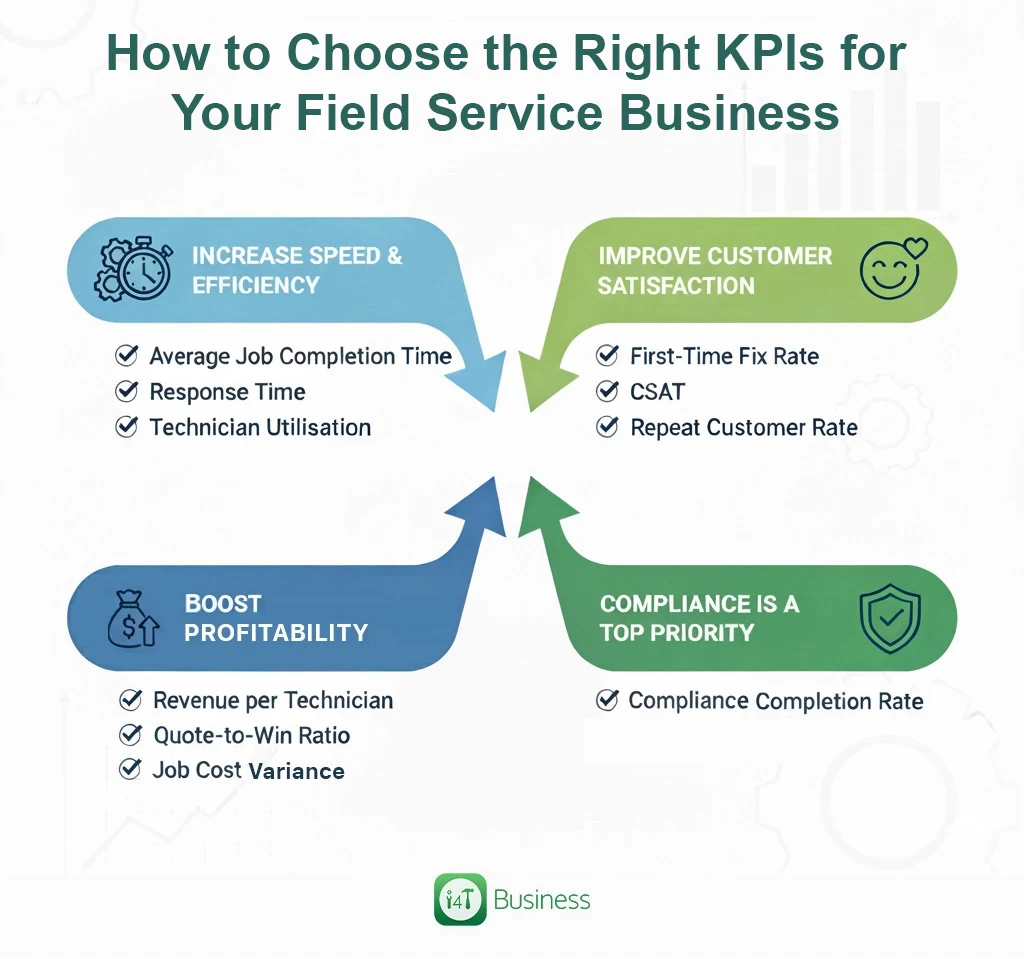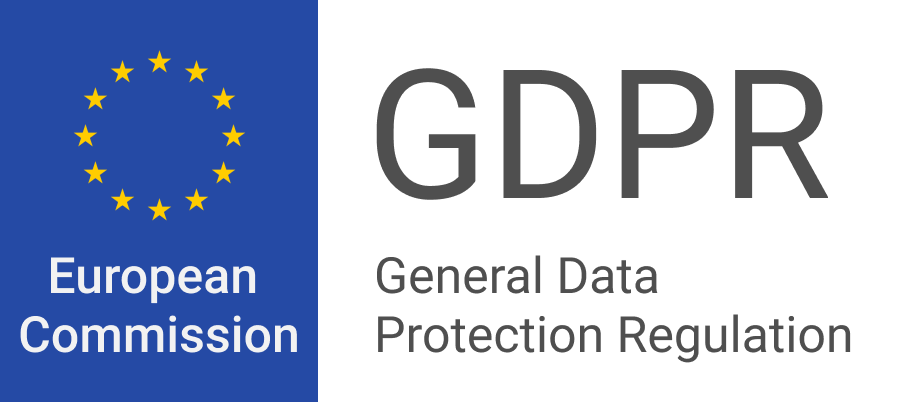Keeping a field service business running smoothly isn’t just about completing jobs. It’s about running an operation that’s efficient, profitable, consistent and trusted. Whether you manage sparkies, plumbers, HVAC techs, maintenance teams or mixed services, the best indicator of how well your business is tracking comes down to one thing: your KPIs.
Key Performance Indicators give you a clear, real-world view of how your business is performing across the field and the office. But with so many metrics you could track, which ones genuinely matter? Which numbers actually move the needle for customer satisfaction, job turnaround, team productivity and profit?
To save you time, this article focuses on the 10 KPIs that genuinely matter for field service, backed by everyday operational logic, answer-engine optimisation, and simple explanations that speak the language of Aussie service businesses.
Let’s dive in.
Why the Right KPIs Matter in Field Service
In field service, small improvements create a massive impact. Saving 10 minutes per job, improving a fix rate, tightening quoting accuracy or boosting customer satisfaction can add up to thousands of dollars and hours saved across the year.
But you can’t improve what you’re not measuring. That’s where KPIs come in.
Great field service KPIs help you:
- Cut down delays and inefficiencies
- Reduce admin time
- Keep techs accountable without micromanaging
- Identify your best-performing jobs and technicians
- Improve customer trust and repeat business
- Predict staffing, demand and revenue
- Make better decisions based on real numbers instead of gut feeling
Modern field service management software makes KPI tracking easier than ever, but before you choose your tools, you need to know which KPIs actually matter.
Here they are.
Top 10 KPIs That Actually Matter in Field Service
Each of these KPIs tells you something meaningful about your business. Together, they give you a powerful picture of how you’re performing today and what you can optimise tomorrow.
First-Time Fix Rate (FTFR)
This is often the most important KPI in any field service operation. FTFR measures the percentage of jobs your techs complete on the first visit, without needing a call-back or additional parts.
A high FTFR means you’ve got the right skills, parts and information going to every job. It shows strong communication between office staff and field teams.
A poor FTFR blows out labour hours, increases fuel costs, frustrates customers and decreases profitability.
How tradies can improve their FTFR:
- Better job notes and site history
- Sending the right technician
- Stocking vans with commonly used parts
- Using digital job records to avoid surprises
If you only track one KPI, make it this one.
Average Job Completion Time
Speed isn’t everything, but predictability is. Average job completion time measures how long it takes to complete a job from dispatch to finalisation.
This KPI helps you understand productivity across your team. If one tech consistently takes double the time of others, you know where support or training is needed.
It also affects scheduling. If you overestimate your speed, you’ll overbook your team. If you underestimate it, you’ll waste availability.
How tradies can improve average job completion time:
- Track travel time vs onsite time
- Provide techs with accurate job details
- Optimise schedules and routes
- Use mobile apps to reduce paperwork delays
Predictable job timings lead to more accurate calendars, fewer reschedules, and happier customers.
Technician Utilisation Rate
Busy doesn’t always mean productive.
Technician utilisation rate is the percentage of a technician’s workday spent on billable work versus downtime, admin or travel.
A high utilisation rate indicates strong scheduling efficiency. A low one suggests wasted hours, poor routing or admin bottlenecks.
But beware, maxing utilisation too high can burn out your team. Balance is key.
How tradies can improve technician utilisation rate:
- Reduce double-handling
- Automate reporting
- Plan jobs in smarter geographic clusters
- Give techs mobile tools that cut down admin time
A well-utilised team is profitable without being overloaded.
Response Time to Job Requests
In a fast-moving field service world, speed to respond can win or lose the job.
Response time to job requests measures how long it takes your office team to acknowledge or schedule a new job request.
Customers often choose the business that gets back to them first. Quick response time also signals a professional work culture and reliable internal workflows.
Businesses aiming for the best field service management standards often highlight quick response as a key customer benefit.
How tradies can improve response time to job requests:
- Use automated job intake
- Assign requests instantly based on location or skill
- Streamline communication workflows
- Use mobile apps so techs can accept jobs faster
Customers remember quick responses, and slow ones.
Customer Satisfaction Score (CSAT)
Customer satisfaction score tell you how happy customers are with the job, usually measured using short survey ratings, star reviews or thumbs-up/down feedback.
CSAT tells you exactly how your service is perceived. Even if your jobs are fast and efficient, if customers aren’t satisfied, you’ll lose future work and referrals.
How tradies can improve customer satisfaction score
- Communicate clearly before and after a job
- Provide accurate ETAs
- Follow up quickly if something wasn’t right
- Keep job notes and photos organised for transparency
Technicians who take two minutes to recap the job at the end often see huge CSAT improvements.
Quote-to-Win Ratio
This is the percentage of quotes that turn into confirmed jobs. Quoting is your first impression. A poor conversion rate can indicate:
- Quotes are too slow
- Pricing isn’t competitive
- Scopes are unclear
- You’re not presenting enough proof of quality
- Follow-up systems are weak
A high conversion rate means customers trust your expertise and presentation.
How tradies can improve quote-to-win ratio:
- Present clear, professional quotes
- Include job photos or notes
- Standardise pricing across teams
- Follow up using reminders or automated messages
- Keep scopes detailed and easy to understand
A strong Quote-to-Win ratio is one of the fastest ways to boost revenue.
Job Cost Variance
This is the gap between your estimated job cost and your actual job cost.
Hidden costs destroy profitability. If your actual costs regularly exceed your estimates, you may be:
- Underquoting
- Underestimating labour
- Wasting materials
- Missing billable extras
- Failing to document scope variations
Understanding this KPI allows you to fix pricing problems before they drain your margins.
How tradies can improve job cost variance:
- Track material usage accurately
- Record job variations immediately
- Keep labour estimates realistic
- Review common job types for patterns
Strong cost control is the backbone of a healthy field service business.
Repeat Customer Rate
This is the percentage of customers who return for additional work.
Repeat customers cost far less to acquire than new ones and often generate more revenue over time.
If your repeat customer rate is low, it may mean:
- Jobs weren’t completed satisfactorily
- Customers forgot about your business
- Your communication after the job was weak
How tradies can improve repeat customer rate:
- Follow up after major jobs
- Use reminders for routine servicing
- Offer membership or maintenance plans
- Keep communication friendly and consistent
High repeat business means you’re delivering trust, not just performing tasks.
Revenue Per Technician
This KPI tells you how much income each technician generates over a set period.
It highlights who’s performing well, who needs support, and whether your operational model is profitable.
If revenue per tech is low, it could indicate:
- Poor scheduling
- Too many non-billable hours
- High travel time
- Incorrect skill-task matching
How tradies can improve revenue per technician:
- Assign higher-value jobs to higher-skilled techs
- Improve scheduling efficiency
- Reduce admin load
- Provide ongoing training
This KPI is essential for forecasting, budgeting and hiring decisions.
Compliance & Safety Completion Rate

Not every field service business needs every KPI. What matters is choosing the KPIs that match your goals.
If you want to increase speed and efficiency these are the KPIs to watch:
- Average Job Completion Time
- Response Time
- Technician Utilisation
If you want to improve customer satisfaction, these are the KPIs to watch:
- First-Time Fix Rate
- CSAT
- Repeat Customer Rate
If you want to boost profitability, these are the KPIs to watch:
- Revenue per Technician
- Quote-to-Win Ratio
- Job Cost Variance
If compliance is a top priority, this is the KPIs to watch:
- Compliance Completion Rate
Whichever KPIs you choose, keep your dashboard simple. A small set of powerful KPIs will always outperform a big, messy list no one pays attention to.
What are Some Common Mistakes When Tracking Field Service KPIs
Even experienced teams fall into traps like, tracking too many KPIs, focusing on numbers instead of context, reviewing KPIs only monthly instead of weekly, using spreadsheets that quickly grow outdated, not training the team on why KPIs matter, and ignoring early warning signs
Strong KPI tracking requires consistency, transparency and tools that minimise manual work.
Bring All Your KPIs Together With i4T Business
Even experienced teams fall into traps like, tracking too many KPIs, focusing on numbers instead of context, reviewing KPIs only monthly instead of weekly, using spreadsheets that quickly grow outdated, not training the team on why KPIs matter, and ignoring early warning signs
Strong KPI tracking requires consistency, transparency and tools that minimise manual work.
FAQs
KPIs (Key Performance Indicators) are measurable numbers that show how well your field service business is performing. They help you track things like job speed, customer satisfaction, technician productivity, profitability and safety so you can make better decisions and improve over time.
.
You don’t need dozens of KPIs. Most field service businesses do well with 5–10 core KPIs that line up with their goals, such as first-time fix rate, response time, quote-to-win ratio, job cost variance and customer satisfaction. The key is to track a few important ones consistently, not everything randomly.
Weekly is ideal for most teams. A weekly review helps you catch issues early, support technicians who are struggling, spot trends and make quick operational tweaks. Monthly reviews are still useful, but they’re better for big-picture planning rather than day-to-day improvements.
You can track KPIs with spreadsheets, but it quickly becomes messy and time-consuming, especially as your team grows. Field service management software automates most of the data collection for you—jobs, times, invoices, quotes, compliance, so your KPIs are accurate, real-time and easy to understand.
i4T Business brings your jobs, technicians, customers and compliance together in one platform, so you’re not chasing data across different systems. It helps you track the most important KPIs, like first-time fix rate, job completion times, utilisation, revenue per tech and customer satisfaction, through clear dashboards and smart workflows. That means less admin, better decisions and a stronger, more profitable field service operation.
Hot off the press!











